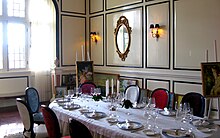Dalat Palace Hotel


The Dalat Palace (Vietnamese: Khách sạn Dalat Palace, French: Hôtel Dalat Palace) is a historic luxury hotel in Da Lat, Vietnam. It was frequented by the colonial French as a popular get-away. The hotel is located at 2 Tran Phu Street, just across from the Xuân Hương Lake.
History
Originally called the Lang-Bian Palace Hotel, it was completed and opened in 1922, at the height of an economic boom, and was designed to be a site of colonial leisure and power. 'The hotels monumentalism, modernity, luxury and location made it a conspicuous symbol of French domination over the Indochinese central highlands.'[1] It was positioned at the centre of a European business and administrative quarter, dominated the "native quarters" and served as a buffer between them and the European villas. As a luxurious establishment it could act also as a serene base from which to explore highland minority villages or conduct big-game expeditions, and meant to compete with the poshest colonial hotels of Southeast Asia, such as the Oriental Hotel, Bangkok and the Raffles Hotel, Singapore.[2] It initially featured thirty-eight luxury rooms, as well as an orchestra, a cinema, tennis courts, private fruit and vegetable gardens, a dance hall, riding facilities, gymnastic equipment and a French restaurant. Architectutrally the Palace followed metropolitan French resort styles, merging elements of spa towns like Vittel with seaside architectural elements borrowed from towns like Cabourg or Cannes. French novelist w:fr:Morgan Sportès, in his depiction of Indochina during WW2, has described it as reminiscent of the Negresco Hotel, in Nice.[3] When economic circumstances changed, later in the 1920s, most plans for government structures in Dalat were abandoned, leaving the town with a Palace Hotel as its monumental centerpiece.

In 1925 a city health inspection reported that the kitchens and their surroundings exhibited, "a condition of considerable filth".[5]
In 1943, under the Vichy governor general of Indochina,
The Lang-Bian/Dalat Palace became the Dalat Palace after the
In the early 1990s reclusive
Literature
- William Warren, Jill Gocher (2007). Asia's legendary hotels: the romance of travel. Singapore: Periplus Editions. ISBN 978-0-7946-0174-4.
References
External links
- Dalat Palace Homepage

